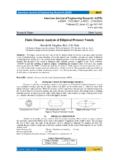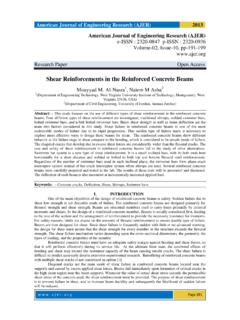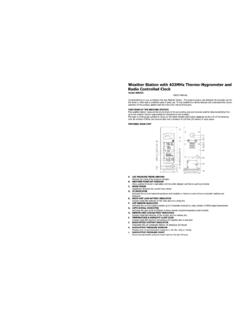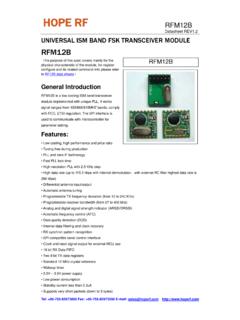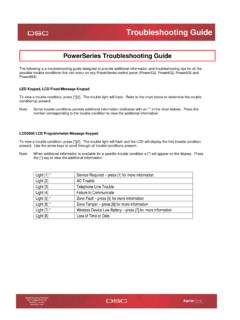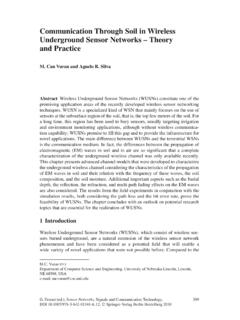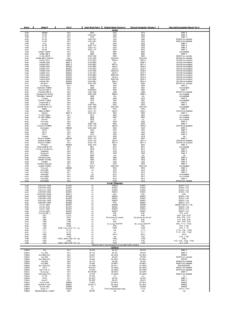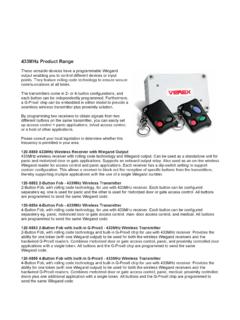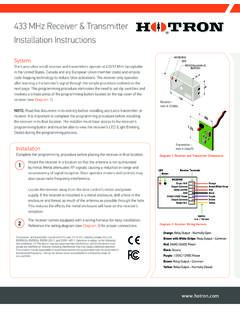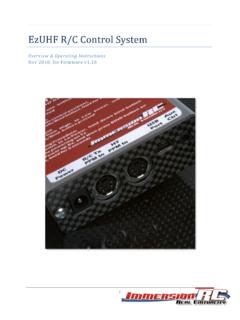Transcription of 433 MHz (Wireless RF) Communication between Two …
1 American Journal of Engineering Research (AJER) 2016 American Journal of Engineering Research (AJER) e-ISSN: 2320-0847 p-ISSN : 2320-0936 Volume-5, Issue-10, pp-358-362 Research Paper Open Access w w w . a j e r .o r g Page 358 433 mhz ( wireless RF) Communication between Two Arduino UNO 1(M. ENGG., BRAC University, Bangladesh) ABSTRACT: Radio frequency (RF) is any of the electromagnetic wave frequencies that lie in the range extending from around 3 kHz to 300 GHz, which include those frequencies used for communications or radar signals.
2 RF usually refers to electrical rather than mechanical oscillations. However, mechanical RF systems do exist. Although radio frequency is a rate of oscillation, the term "radio frequency" or its abbreviation "RF" are used as a synonym for radio , to describe the use of wireless Communication , as opposed to Communication via electric wires. To receive radio signals an antenna must be used. However, since the antenna will pick up thousands of radio signals at a time, a radio tuner is necessary to tune into a particular frequency (or frequency range). This is typically done via a resonator in its simplest form, a circuit with a capacitor and an inductor form a tuned circuit.
3 The resonator amplifies oscillations within a particular frequency band, while reducing oscillations at other frequencies outside the band. Another method to isolate a particular radio frequency is by oversampling (which gets a wide range of frequencies) and picking out the frequencies of interest, as done in software defined radio. The distance over which radio communications is useful depends significantly on things other than wavelength, such as transmitter power, receiver quality, type, size, and height of antenna, mode of transmission, noise, and interfering signals. Ground waves, tropospheric scatter and sky waves can all achieve greater ranges than line-of-sight propagation.
4 The study of radio propagation allows estimates of useful range to be made. Our aim is design & implementation a Communication bus bar is show Communication between transmitter and receiver via Arduino. Keywords: Arduino Uno, RF, Module, Baud, Serial Bus. I. INTRODUCTION Arduino is a hardware and software company, project, and user community that designs and manufactures computer open-source hardware, open-source software, and microcontroller-based kits for building digital devices and interactive objects that can sense and control physical devices. The project is based on microcontroller board designs, produced by several vendors, using various microcontrollers.
5 These systems provide sets of digital and analog I/O pins that can interface to various expansion boards (termed shields) and other circuits. The boards feature serial Communication interfaces, including Universal Serial Bus (USB) on some models, for loading programs from personal computers [1]. For programming the microcontrollers, the Arduino project provides an integrated development environment (IDE) based on a programming language named Processing, which also supports the languages C and C++ [2]. The first Arduino was introduced in 2005, aiming to provide a low cost, easy way for novices and professionals to create devices that interact with their environment using sensors and actuators.
6 Common examples of such devices intended for beginner hobbyists include simple robots, thermostats, and motion detectors. Arduino boards are available commercially in preassembled form, or as do-it-yourself kits. The hardware design specifications are openly available, allowing the Arduino boards to be produced by anyone. Adafruit Industries estimated in mid-2011 that over 300,000 official Arduinos had been commercially produced and in 2013 that 700,000 official boards were in users' hands. II. RF(TRANSMITTER & RECEIVER ) MODULE The RF module, as the name suggests, operates at Radio Frequency.
7 The corresponding frequency range varies between 30 kHz & 300 GHz. In this RF system, the digital data is represented as variations in the amplitude of carrier wave. This kind of modulation is known as Amplitude Shift Keying (ASK) [3]. Fahmida Ahmed1, Shakh Md. Alimuzjaman Alim2, Md. Shafiqul Islam3, Kanti Bhusan Roy Kawshik4 , Shafiul Islam5 2,3,4,5(EEE, Atish Dipankar University of Science & Technology, Bangladesh) American Journal of Engineering Research (AJER) 2016 w w w . a j e r . o r g Page 359 Transmission through RF is better than IR (infrared) because of many reasons. Firstly, signals through RF can travel through larger distances making it suitable for long range applications.
8 Also, while IR mostly operates in line-of-sight mode, RF signals can travel even when there is an obstruction between transmitter & receiver. Next, RF transmission is more strong and reliable than IR transmission. RF Communication uses a specific frequency unlike IR signals which are affected by other IR emitting sources. This RF module comprises of an RF Transmitter and an RF Receiver. The transmitter/receiver (Tx/Rx) pair operates at a frequency of 434 MHz. An RF transmitter receives serial data and transmits it wirelessly through RF through its antenna connected at pin4.
9 The transmission occurs at the rate of 1 Kbps - transmitted data is received by an RF receiver operating at the same frequency as that of the transmitter [5]. The RF module is often used along with a pair of encoder/decoder. The encoder is used for encoding parallel data for transmission feed while reception is decoded by a decoder. HT12E-HT12D, HT640-HT648, etc. are some commonly used encoder/decoder pair ICs. Fig 1: RF Module Fig 2: PIN diagram of RF Module III. SPECIFICATIONS Transmitter: Working voltage: 3V - 12V for max. power use 12V Working current: max Less than 40mA max , and min 9mA Resonance mode: (SAW) Modulation mode: ASK Working frequency: Eve 315 MHz Or 433 mhz Transmission power: 25mW (315 MHz at 12V) Frequency error: +150kHz (max) Velocity : less than 10 Kbps So this module will transmit up to 90m in open area.
10 Receiver: Working voltage: + Working current: max Working method: OOK/ASK Working frequency: Bandwidth: 2 MHz Sensitivity: excel 100dBm (50 ) Transmitting velocity: < (at 315 MHz and -95dBm) the use of an optional antenna will increase the effectiveness of your wireless Communication . A simple wire will do the trick. American Journal of Engineering Research (AJER) 2016 w w w . a j e r . o r g Page 360 Materials: at first let's take a look for what we need: 1) 2 Arduino Board "I used Uno" 2) RF 315 MHz or 433 mhz transmitter-receiver module. 3) Jumper wire. 4) Breadboard. 5) External Power supply (9V Battery *2) "Optional.
